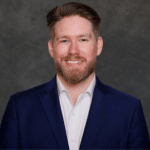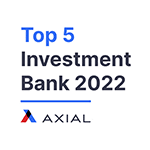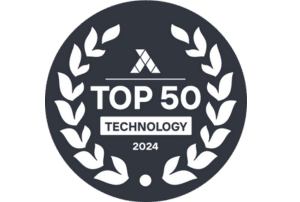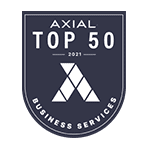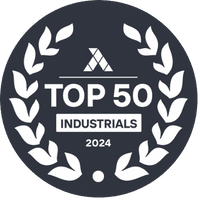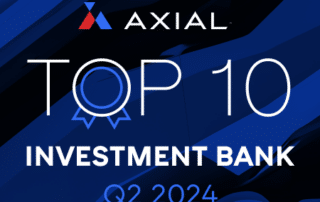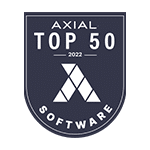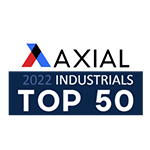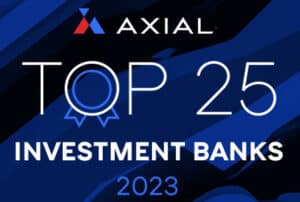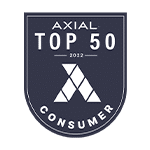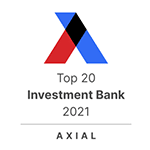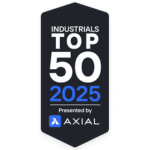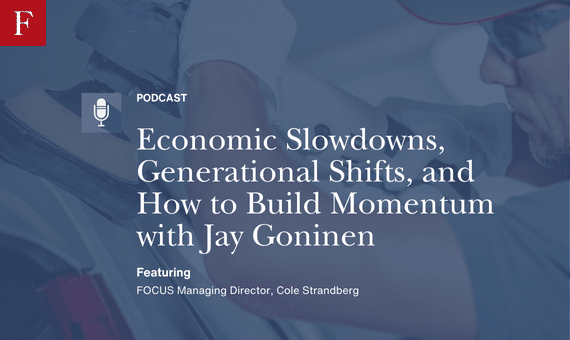
Economic Slowdowns, Generational Shifts, and How to Build Momentum with Jay Goninen
On this week’s episode, Cole Strandberg chats with Jay Goninen. During this discussion, they zoom out for a high-level look at the current state of the industry: technician shortages, economic slowdowns, generational shifts, and how forward-thinking shop owners can use this moment to build momentum. If you’ve been wondering where the labor market is heading—or how to prepare your shop for what’s next—you’re in the right place.
Cole Strandberg: For anyone watching on YouTube, you can see I’m doing my best Mike Anderson impersonation on his on the Road podcast here on the Autobody. Net Auto Body News Network. I am on the road, so you’re catching me in a hotel room. Nonetheless, looking forward to an awesome conversation with you. We talk all the time Jay, when we’re together about the technician shortage. That’s where you spend a lot of your time. Obviously there are some changes happening, I think across the landscape in the collision repair industry. What are you Seeing just kind of latest finger on the pulse of the talent shortage and its status.
Jay Goninen: I do think you’re hearing a little bit more about shops just slowing down in general and it’s still kind of mind blowing to me, to be honest. I think you’ll hear some of the publications that might talk about it and it kind of is mixed bag. When I’m talking to shops, I think some of them are busier than others. You still hear from some of the shops that are slammed. Right. And still can’t keep up with the demand. But there is more and more. There are more and more shops that have been talking through maybe a slowdown and how that’s impacted what they need for staffing right now. So I, I do, I do sense maybe a little bit less pressure on shops to find that skilled talent and maybe that pendulum has swung to needing more work to come in the doors. Right. And so definitely concern there. But I do think there are a fair number that are still relatively busy.
Cole Strandberg: 100%. It’s not the way we wanted to solve the technician shortage. Right. But it’s certainly a short term from a, you know, that perspective. Supply is starting to meet demand. I don’t anticipate that’s a super long term thing. I certainly hope not. Along with all of our listeners here, I’m going to drop a link in the show notes to an article on auto body news that showed the body tech job openings have dropped to the lowest point since the summer of 2020. Do you think that is just a supply and demand issue? Do you think we’ve caught up? Do you think some of the efforts we as an industry have made are starting to kind of move the needle as well?
Jay Goninen: I’d like to say that the efforts have helped us catch up. I do think it’s made a dent. I do think this is probably more reflective of how busy the shops are in general. Right. And when I look at it, it does. With any article I’ve read. I’d like to get a little bit more of a broad view of the entire industry. Right. The entire collision industry. Because if you look, I had just pulled up a report from the Department of Transportation and this is a trailing report. Right. So this is from August of 2025. But at that time vehicle miles driven was up one and a half percent. So the, the miles driven has actually gone up again. That’s trailing data. So maybe that changed over the summer. But that is some reason for concern of, you know what, why, why would the fall off happen if the miles driven has actually gone up. And so, you know, when I look at that, I think there is maybe it’s maybe more of a reflection of a business slowdown versus an actual catching up to the technician shortage. Now, as we talk through this, I think one of the things that I would point out is that I don’t think this is a long term thing. Right. I do think maybe the ways that people are going about how they get their vehicles fixed might change. I do know if you look at data, people’s vehicles are getting older, right. They’re driving their vehicles a lot longer. Maybe that doesn’t, you know, if, if they were to get an offender bender, maybe they take the cash rather than actually fixing their vehicle. Right. So I, I do think there are probably a number of different variables, but I do think this also opens up a tremendous opportunity for those shops that might just have enough people right now. Right. Like they’re, they, they’re sitting pretty good and maybe are a little nervous about adding an additional body. And my one word of caution is very similar to a LinkedIn video I had put out in 2020, which was the advice of the great Warren Buffett, is when you get kind of the. I’m going to murder this quote, I’m not going to say it correctly, but basically what he says is that if everybody’s running one direction, run the other. And this might be a great opportunity for a shop that’s out there to start develop, developing their own program for developing their own technicians. If you’re confident that business is going to be coming back and you’re in kind of a slow time right now, it’s a great time to take the excuses away from growing that next generation of technician up for your shop. And you know, I think people thought I was crazy when I put that out in, I don’t know, it was like April of 2020 and there were a lot of large groups that were just letting go of hordes of people and good people. You know, if, if you have the chance to get that great technician, yes, it causes maybe a cash flow issue in the short term, but maybe that puts a little bit more pressure on you to go find that business and, and really maybe being better at attracting new customers and figuring out why has it slowed down so much. So for me, maybe it’s the optimist in me that kind of sees the light in any situation. But I would look at it through the lens of you finally have an opportunity that the excuses that you’ve had for the last five years of we’re too busy to put any program in place or too busy to do anything. Those excuses are kind of out the window right now if you’re slow, right? So use that opportunity to your benefit and really help it, help it help you, help you help yourself grow a long term sustainable plan for the future.
Cole Strandberg: Be bold when others are fearful, I believe is another rendition of that Warren quote and it’s, it’s facts, man. I, I can’t tell you how many businesses who I’ve worked with who took some really aggressive moves back in 2020 when people thought that was just an insane thing to do. They, they made great strides much quicker than you would in a more normal environment. And so maybe that is just, just this example here you are. Obviously the theme of this month is collision repair influencers. You’re the rare breed that goes beyond influencing and just collision repair. You kind of have the whole automotive services ecosystem talking on the macro. Are we seeing similar trends in the world of tires and auto repair in terms of these slowdowns and maybe some folks waiting to get these repairs done for when they have a little more certainty on the macro?
Jay Goninen: I don’t think we see it as much on the, on just the general service side. Right. I don’t see these slowdowns as much as I’ve heard about the noise from the collision side. I don’t seem to hear that as much on the repair side. Now I do think there’s a lot of concern over what’s going to happen with all of the advancements in technology. Right. I think there’s a lot of concern about adas and keeping up with adas. Are you contracting that out or are you handling that internally? I do think it’s a hard decision to make it at times. Right. If you’re going to go spend a lot of money on expensive equipment, you know, are you worried that maybe that equipment is going to be obsolete in five years, so you’re going to spend all this cash and then maybe not have as much of a reason to have it or, you know, are you, do you have the staff to handle some of that, that different type of repair and diag and just, you know, I think from, from a business owner perspective, I get the sense that that does make people a little bit nervous because you could make a huge investment for a gigantic paperweight to sit in the side of side of your shop. Now I think a lot of collision shops have done a good job embracing that or finding good partners that really help them out through that process. But I think as a Whole that is one of the things that is really at times hard to get your hands around. And not only I’ve talked to several people about this, that at times the OEMs really don’t have their stuff together on specs for some of the adas stuff. Had a good example Kurt with ICAR was telling me about. He had a student reach out to him and said that they put a 2 inch lift kit in like an F250 and there’s no correct spec on what you’re supposed to do for that repair. Right. You’re like technically supposed to put it back down to like standard ride height and do the calibrations. But to his point he was like, well then it doesn’t make any sense for like you’re raising it back up again, like it’s not going to be accurate. So, you know, I think there’s, there’s still a lot to be worked out on that end. And still, you know, for our industry we’ve kind of got, we’ve got to get some of this a little better, a little more accurate in general.
Cole Strandberg: Well, man, you and I are both optimistic people admittedly, and so we’re always going to put maybe sometimes an annoyingly positive spin on things. But man, these opportunities for the folks who have the right mindset or these challenges rather represent some tremendous opportunities out there. And I think a lot of really good stuff as an industry working together to tackle these challenges. When you first came on the collision vision, that was probably two years ago now, you were really, admittedly not a collision guy. That has changed. I hate to tell you, but that has changed. You are a collision guy now, Jay.
Jay Goninen: I just, I feel like I know a lot more collision people that actually tell me what’s going on than any expert in any regard on the collision side. Just really been fortunate over the last few years to really get to know some great folks on the collision side and get their feedback and get their honest opinions on the industry. And you know, I do give a lot of credit to the folks at ICAR for kind of bringing me up to speed on a lot of things. And you as well, right? You’ve really made a lot of introductions for me to people that have helped me get some of that industry knowledge. Still, still very, very novice compared to so many of the fine folks that listen to this show. But when I speak about this topic, it’s from the feedback that I get from my other friends in the industry.
Cole Strandberg: Right there with you, man. The single biggest source of gathering knowledge has been the Collision Vision. And I’m sure the same to an extent with you on beyond the Wrench. And I want to talk some more about that later today in our conversation. For those who don’t already listen in weekly, we want to make sure to give a plug there. I don’t know if too many people with a better finger on the pulse of some of these talent issues, both at the shop level because of who you work with, but also you mentioned icar, you mentioned groups like that at the macro level where there is a tremendous push being done to address the talent shortage, to address young people and new entrants into the industry coming into Collision Repair. Now, I know you’re working on some exciting things, much of which may very well be confidential, but can you tell us a little bit about, from your perspective, what’s going on from some of those macro movers out there?
Jay Goninen: I think it’s a big push on education, right. And making sure that we’re properly training that next generation, knowing that these advancements in technology have come and are coming full speed ahead. Right. So I think the folks more on that macro side are starting to take a step back and look at it from a macro view, right. Instead of just kind of constantly hearing from folks that, you know, we have this technician shortage, they’re actually doing some things to, to address that. And I look to like ICAR with Collision careers doing a fantastic job and kind of taking a lead on that. And I think that’s a really, really fantastic thing to do. Just really branding what this profession is all about. And it’s not just wrench way, it’s not just ICAR or Collision Careers. There are so many people that are rowing in the right direction now. And I think when, when those folks more at that macro level level look at it, they are trying to look for long term sustainable programs that can continually bring new talent in, knowing that, you know, if we’re competing against other trades, if we’re complete competing against plumbers, we’re competing against electrical companies, we’re competing against all of these other skilled trades that frankly pay really well and have good benefits and have a lot of things that we have to really take seriously when we’re trying to appeal to these young folks. I think that’s when we start to make an actual impact on the industry is that when we get to that source. Now that’s not the only piece of this either, right? There are, there’s a lot of data behind the fact that at times we have a retention problem, we have a, we have A problem with keeping people in the industry. And I still think that’s a fact, even with the data that we’ve seen recently that you know what, we still need to figure out ways to make our techs happier. We need to figure out ways that that 60 year old that’s getting close to retirement goes away really, really happy rather than spiteful. And maybe, you know, going on social media and saying why in the world would you ever expose yourself to chemicals? Why in the world would you ever do any of this stuff? Right? So, you know, I think to me there’s, there’s kind of two sides to that equation where we need to pull more people in, but we really do need to look at the people we already have and, and how happy they are and at a local level for that local shop that’s maybe concerned about that or isn’t concerned, but should be concerned about that. I think having conversations with your team and just getting a sense to how happy they are and you know, I think the deeper you can get in some of these one on one conversations with team helps you understand what you can do to, to make their life a little bit better. And by doing that, I think that helps the rest of the pipeline come along.
Cole Strandberg: Man, you get me fired up every time we talk. And it’s why I’m a regular listener of your beyond the Wrench podcast. Give us a quick pitch on that for folks who have not yet tuned in.
Jay Goninen: Yeah, just similar to this, really talking about how we make the industry a better place. What’s different about it is that it’s kind of all aspects of automotive. Right. We have a mix of collision service, both the, the dealer side, the independent side. We get our diesel folks involved quite a bit as well. But always just talking about best practices. And some of the episodes we’ve recently released and have coming up to release soon are really, really exciting. We just had an author on by the name of Dave Anderson who he wrote a book called Unstoppable and I, we recorded this. We as, as we record this. We haven’t released that episode yet, but maybe one of my favorite episodes we’ve ever done. His advice, just a crazy smart guy side note, if anybody’s ever looking for a keynote speaker, that’s a great one, but that was a cool one. We just did one with a tech that works for the Secret Service and really works hand in hand with the president and vice presidents and has for several years some incredible stories. That one was probably the most difficult episode I’ve had to re record because you really had to watch your P’s and Q’s. We had to go back and forth with them on what could be recorded, what had to be edited out. We actually recorded extra long because we knew they were going to take pieces of it out. We just didn’t know which pieces they would take out. But a fascinating listen. So just a lot of really, really good guests and hopefully we get you back on here sometime soon.
Cole Strandberg: I love it, man. Anytime. Happy to be there though I think I’m a whole lot less interesting than a couple of those you just mentioned. Amazing stuff. One thing as you know, because I do it to you a lot, I love putting good people in touch with good people in this industry. You’re always so gracious for that. For folks who want to skip me and the Middleman, how can folks get in touch with you and follow along with all that you have going on?
Jay Goninen: I’m normally very active on LinkedIn, although I have to apologize that probably the last few weeks, maybe month or two, I haven’t been as active and it’s been just because of travel schedule. Not a great excuse because you can Always look at LinkedIn while you’re in the airport, but it is one of those things where it goes kind of back of mind when you’re on the road. So I’ve been on the road a lot lately. I think that’s going to hopefully slow down just a little bit here coming up and hopefully get more engaged out there again. But feel free to connect with me. Shoot me a message on LinkedIn that a lot of times is the best place to get a hold of me.
Cole Strandberg: I will go ahead and link that in the show notes. Jay, a pleasure as always my friend. Thank you for joining us once again. I think at this point, very safely the most frequent guest here on the Collision Vision for great reason. Really appreciate you.

